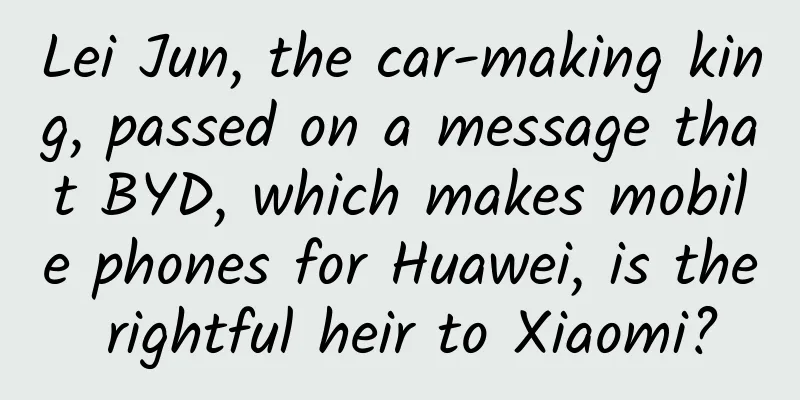Lei Jun, the car-making king, passed on a message that BYD, which makes mobile phones for Huawei, is the rightful heir to Xiaomi?

|
At this year's Xiaomi Spring New Product Launch Conference, Lei Jun officially announced Xiaomi's entry into the smart car industry. Unsurprisingly, the news attracted public attention, because Xiaomi, a company that debuted with a light-asset business model, suddenly announced its entry into the car manufacturing field, which is generally recognized as a heavy-asset field. This makes people involuntarily curious about how Xiaomi will build cars. Recently, BYD CEO Wang Chuanfu has frequently talked about Xiaomi's car manufacturing in public, implying that BYD is the most suitable company to cooperate with Xiaomi in car manufacturing. This makes people wonder why BYD would take the initiative to cooperate with Xiaomi. Is BYD really the only choice and the destined one to be Xiaomi's car manufacturing partner? Self-production or OEM? Which way will Xiaomi go in making cars?Xiaomi does not have much experience in car manufacturing. Lei Jun said at the press conference that Xiaomi only did 75 days of research before announcing its official entry into the automotive field. To date, Xiaomi has only more than 40 patents in the field of car manufacturing, while Huawei already has 357 patents. It can be said responsibly that Xiaomi is basically a novice in the field of car manufacturing. When it comes to production issues in today's smart car industry, there are only two options: self-production and OEM. Compared with the OEM model generally chosen by new players in the car manufacturing field, traditional car companies prefer the self-production model. The core reason is undoubtedly that the self-production model has more advantages in manufacturing. First, product quality will be more reliable, because manufacturers can fully control the automobile production process and be more meticulous in factory quality inspection compared to outsourced factories. A typical negative case here is that Xiaopeng Motors initially outsourced its production to Haima Automobile, which eventually led to a brand disaster in which users protested against poor quality at the auto show. Secondly, the self-production model has a greater advantage in manufacturing costs. As a new brand that has just entered the automotive market, because of its small order volume, it will be at a disadvantage when negotiating with OEM factories, and the cost of the whole vehicle will be forced to increase, and it will lag behind the same level of cars in terms of cost performance. However, the OEM model also has its own unique advantages. The most important of which is that it does not require much experience from new car companies in automobile manufacturing, and it can also achieve stable mass production of automobiles. This is the main reason why new car manufacturers including NIO, Xpeng and Ideal adopt the OEM model in their early stages. In addition, Lei Jun has publicly stated that Xiaomi's first car will be launched in about three years, and by then it will represent the cutting-edge level in the automotive field. It can be seen that the self-production model that requires starting from scratch is not suitable for Xiaomi, whether in terms of the degree of accumulation of manufacturing experience or the limitation of product launch time. Therefore, the OEM model that does not require high manufacturing experience and can quickly mass-produce has become the only choice for Xiaomi to build cars. A perfect match, but still missing the finishing touchIf you want to find a foundry that is most suitable for Xiaomi to build cars, then BYD, which has recently frequently called out to Xiaomi, is obviously the most "well-matched" one. The cooperation between the two will produce a "1+1>2" effect. For Xiaomi, its biggest advantage in the field of smart cars is that it has what can almost be called the most complete and largest IoT ecosystem in the world. Last year, the number of IoT devices in Xiaomi's IoT ecosystem, excluding mobile phones and computers, reached 289 million. With a complete IoT ecosystem, Xiaomi Auto can interact with users' other Xiaomi IoT devices to provide users with a seamless smart experience. For example, it can automatically start the smart scene mode at home when it detects that the user has gotten out of the car, etc. This is something that neither traditional car companies nor new car-making forces can match. In the field of automobile manufacturing, which Xiaomi is not good at, BYD can provide Xiaomi with unique OEM support. BYD, which has been deeply involved in the field of new energy vehicles for many years, has made commendable achievements in this field. Its own brand of new energy vehicles has landed in more than 50 countries and regions around the world, and its domestic sales have repeatedly set new records. For example, in May this year, BYD sold 32,800 new energy vehicles, a year-on-year increase of 289.6% compared with the 11,325 vehicles sold in the same period last year. Its experience in automobile manufacturing can be said to be undoubtedly rich, and its product quality is obviously better than that of some small factories. In terms of cost control, BYD has achieved industry-leading control over vehicle manufacturing costs by relying on its business philosophy of full industry chain layout. For example, the Qin PLUS DM-i hybrid vehicle launched in March this year has a fuel consumption of only 3.8L per 100 kilometers, and the assembly cost is as low as 10,000 yuan per set. From this perspective, the cooperation between Xiaomi and BYD may be its last choice on the road to car manufacturing. However, the two parties still have not reached a consensus on whether to cooperate or not. In a recent interview, BYD CEO publicly claimed that they had made many mobile phones for Xiaomi and Huawei, but in fact BYD only did low-tech assembly work in the industry chain. Being at the downstream of the industry chain, it could only get a very low profit of 11.2%, much less than that of upstream component manufacturers. Therefore, in the smartphone industry, BYD, as an assembly plant, does not have a high status. However, in the smart car industry, the positions of Xiaomi and BYD have to be reversed, because the technology involved in smart car foundries is much greater than that of smartphone assembly plants, and the profits are much higher. Since Xiaomi does not have much accumulation in the field of car manufacturing, it does not have much say in front of large-scale foundries. However, because Xiaomi previously made mobile phones to find small foundries to reduce costs, which eventually led to the pain of the product being criticized, Xiaomi no longer dares to find some small foundries that can be lowered in the automotive market that attaches more importance to product safety. Therefore, Xiaomi is left with only mature large foundries such as BYD and Great Wall. Therefore, BYD, which occupies a dominant position in the industry, frequently initiates remote interactions with Xiaomi. BYD CEO publicly expressed his concern that Lei Jun would go the wrong way in making cars, which actually implies that if Xiaomi does not allow BYD to make cars on a contract basis, and instead looks for other contract manufacturers or adopts a self-production model in order to save costs, then Xiaomi will waste several years of market opportunities. However, Xiaomi did not respond to BYD's statement, and rarely treated the public opinion coldly. At the same time, Lei Jun frequently appeared in the R&D centers of car companies such as Wuling and Great Wall, revealing that Xiaomi is not short of OEM partners and lowering BYD's bidding space. Overall, BYD is not satisfied with the low profits from OEM mobile phones, and intends to rely on its position in the new energy vehicle manufacturing field to win the OEM rights for Xiaomi cars, thereby participating in the future development of Xiaomi cars and taking the opportunity to obtain high profits from OEM cars. However, although Xiaomi faces the problem of insufficient experience in car manufacturing and a limited number of partners to choose from, and BYD is indeed one of the best options for cooperation, it does not want BYD, which occupies a dominant position, to take away too much profit, so it has not made any response to BYD's repeated statements. At present, the two parties can be seen as in a relationship of raising and lowering prices. As for whether the cooperation can be perfectly achieved in the end, it depends on which party will give in first. As a winner of Toutiao's Qingyun Plan and Baijiahao's Bai+ Plan, the 2019 Baidu Digital Author of the Year, the Baijiahao's Most Popular Author in the Technology Field, the 2019 Sogou Technology and Culture Author, and the 2021 Baijiahao Quarterly Influential Creator, he has won many awards, including the 2013 Sohu Best Industry Media Person, the 2015 China New Media Entrepreneurship Competition Beijing Third Place, the 2015 Guangmang Experience Award, the 2015 China New Media Entrepreneurship Competition Finals Third Place, and the 2018 Baidu Dynamic Annual Powerful Celebrity. |
<<: Nezha of the people, created by the people! An open letter from Nezha Auto's Zhang Yong to users
>>: Raven CEO Lu Cheng: Raven R is not only a smart speaker, but also a six-axis emotional robot
Recommend
Payment logic: Why should users give you money?
In this world, it is not easy for a person to mak...
Online operation promotion: 4 steps to target user analysis!
When promoting and operating online , you will of...
Pinduoduo event operation analysis!
On the eve of Double Eleven, Pinduoduo launched a...
This tree has a "ghost face", but it is loved by people...
Many people shudder when seeing the word "gh...
How to operate a community in 2020!
“No one speaks in the group, it’s not active at a...
The mobile revolution is coming to an end: where is the blue ocean of the future?
If we count the history of computers from Sir Bab...
Android Getting Started - Button Control + Custom Button Control
The first step is to drag a Button control into t...
Dongfeng Peugeot is publicly reducing configuration but not lowering prices. Is this something or is there some other trick?
If it is a normal product, you get what you pay f...
What should Sharp learn from Japanese rice cooker and toilet seat companies?
Following the bad news of heavy debt, selling bui...
How to formulate a brand strategy?
Brand has become one of the strategic factors in ...
Detailed explanation of the underlying implementation and principle of LinkedList data structure
[[420549]] Preface In daily development, collecti...
Attention, children in the 21st century! Programming has become a must-have skill
If children hope to find jobs in the 21st century...
Operational Tips | How to reach users? Share 36 strategies!
Middle-aged people may have heard of "First ...
How to go from "white soil" to "oasis"? Let's see the "salty confession" of the earth
In ancient my country, people have already realiz...
C919 soars on a new route! China's large aircraft's soaring journey
Author: Duan Yuechu and Huang Xianghong Under the...









